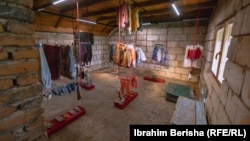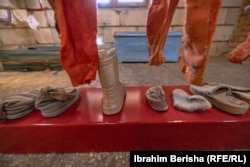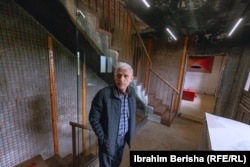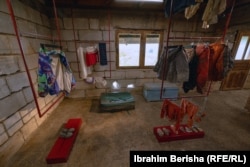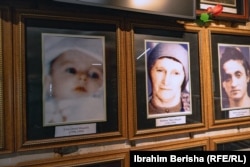POKLEK, Kosovo -- Children's clothes, notebooks, and family mementos from 53 Albanian civilians -- mostly children, women, and the elderly -- stand in eerie silence, remnants of a massacre that took place 25 years ago.
A humble, dilapidated house, nestled in the central Kosovar village of Poklek, has become an unlikely museum where visitors are confronted with a horrific war crime perpetrated by Serbian forces during the Kosovo War of 1998-99.
Fadil Muqolli still has difficulty entering the house that was formerly his home -- a home that other families sought refuge in that spring day. He has visited it hundreds of times during the last two decades.
"It is a feeling that is difficult to put into words," he said, before recalling how he went to the house to gather the bones of all of the children and his family members.
"Today, when I bring my hands close to my face, I can still feel the smell of the children's bones," he says.
Among the 24 children who were murdered and burned on April 17, 1999, were his daughter, Shehidja, 14, and his boys Naseri, 12, Ylberi, 10, and Egzoni, 4.
Muqolli, who was a member of the Kosovo Liberation Army (KLA), was not at home during the attack, which also claimed his wife. The burned victims of the massacre were discovered a day later.
Twenty-five years after they met their untimely deaths there, the house has become a museum.
"For us family members, it is a very difficult place to visit, let alone maintain," says Muqolli.
"I never thought it would become a museum," he says, before adding, "I have kept these [personal belongings] to remind me of the family members who were killed."
However, as there is no guide to inform the visitors about the tragic event that unfolded there, the doors remain locked.
Adorning the walls of the house are pictures of the victims.
Photographs taken shortly after the massacre are also exhibited.
The Muqolli family was not the only family murdered in the house; the Cerraku, Elshani, and Hoxha families also perished there. The house is one of the rare buildings that has remained standing. Hundreds of similar houses have been bulldozed or destroyed.
Many of the surviving family members hope that one day the perpetrators will be punished; others have lost hope that justice will be served.
During Kosovo's war of independence -- which lasted from February 28, 1998, until June 11, 1999 -- numerous war crimes were committed by all sides. More than 13,000 people -- 76 percent of whom are believed to have been civilians -- died in Serbia's former southern province. Most of the victims were ethnic Albanians. The fighting ended in 1999 after NATO air strikes against the now-defunct Yugoslavia.
The search continues for more than 1,600 people missing in the war.




